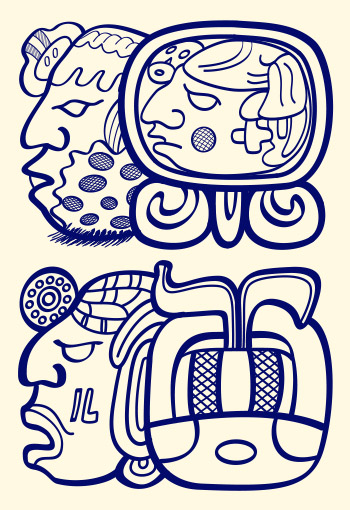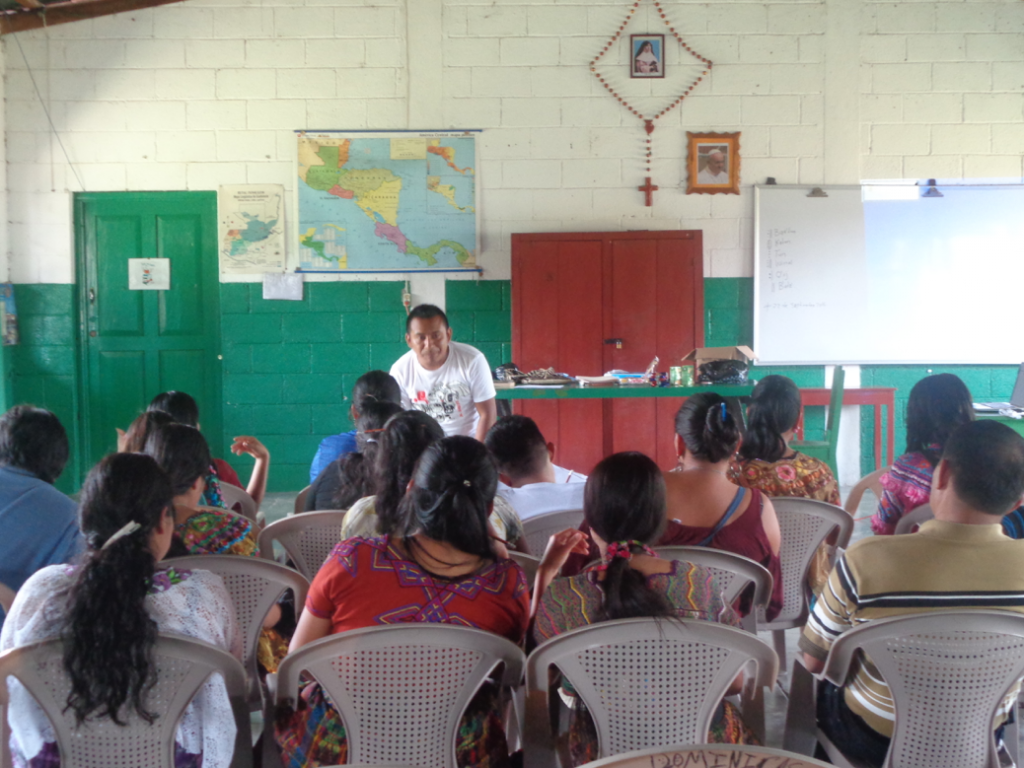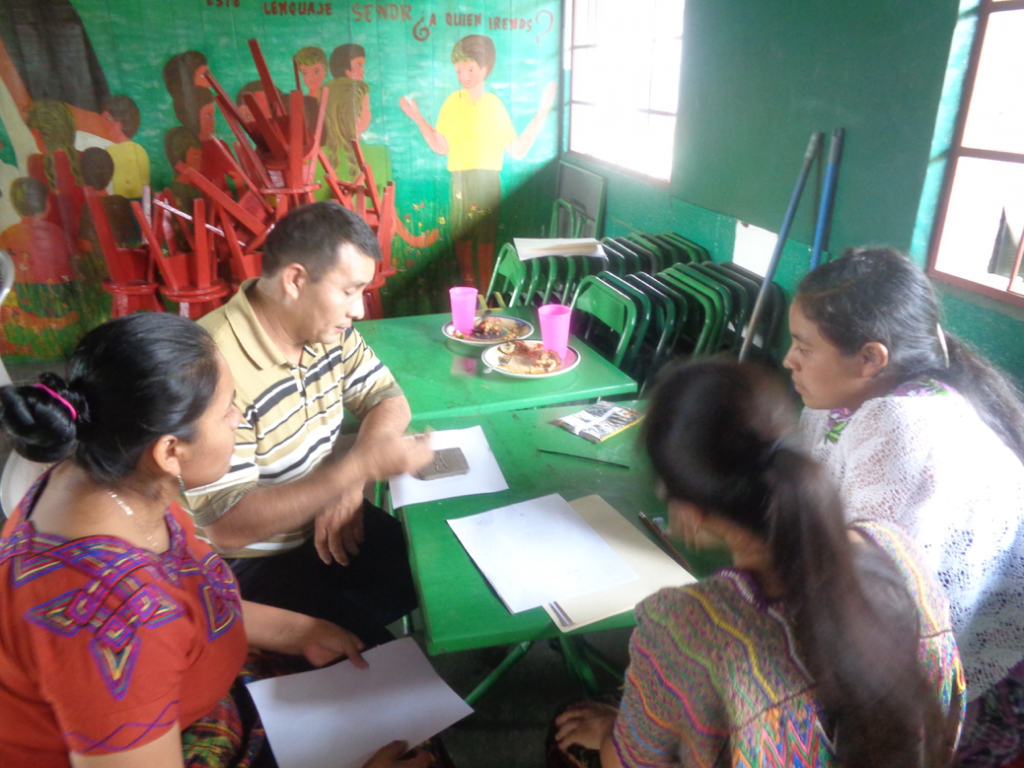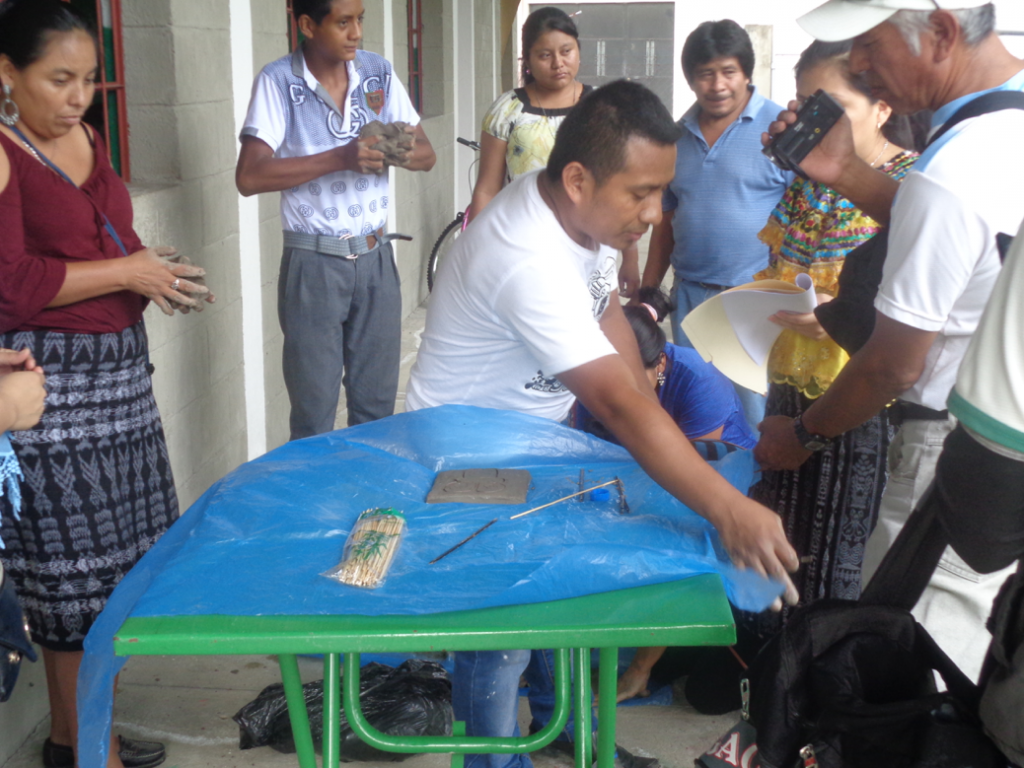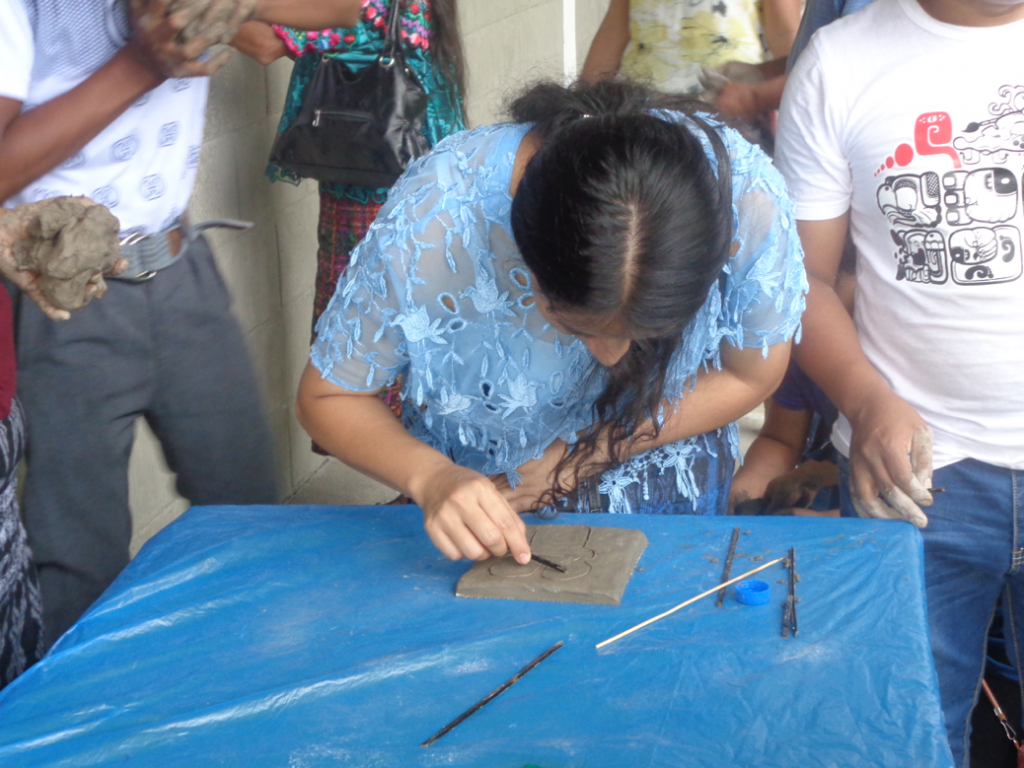We look forward to funding more workshops like this one, which bring together Maya people from multiple communities to learn and study the writing of their ancestors. We also appreciate Mateo’s insights and recommendations for the future as we work together towards our shared goals.
Maya Epigraphy Workshop Report
September 22, 2016
Cubulco, Baja Verapaz
Mateo Ajualip Rodríguez
INTRODUCTION
Escribiendo Nuestros Nombres en la Tierra:
Taller de Escritura Maya Antigua en Cubulco, Baja Verapaz, Guatemala
Hoy es 9 Ajaw y ha transcurrido exactamente un Tzolk’in desde el Tercer Congreso Internacional de Escritura Jeroglífica Maya, y este mes publicamos el informe de un taller dirigido por Mateo Ajualip Rodríguez en la communidad Achí de Cubulco, Baja Verapaz, Guatemala. Para concluir su taller, Mateo hizo que sus treinta participantes tallaran sus nombres en barro usando la escritura maya.
También quisiera aprovechar esta ocasión para agradecer a todos los que donaron anuestro fondo durante las vacaciones, y para anunciar que estaremos de nuevo aceptando solicitudes de mini-becas a partir del 1º de marzo!
Esperamos poder financiar más talleres como este, que reúnen a personas mayas de múltiples comunidades para aprender y estudiar la escritura de sus antepasados. También apreciamos las ideas y las recomendaciones de Mateo para el futuro y trabajamos juntos hacia nuestros objetivos compartidos.
Maltiox,
Michael J. Grofe, Presidente
Informe de Taller de Epigrafía Maya
Proyecto: Taller de epigrafía Maya
Ejecutado: 22 de septiembre de 2016
Lugar: Cubulco, Baja Verapaz
Horario: De 8:00 a 16:00 horas
Responsable: Mateo Ajualip Rodríguez
PRESENTACIÓN
In the context of the demand for language and culture in the municipality of Cubulco, Baja Verapaz, the Ojeer Mayab ‘Tz’iib’ (Maya Epigraphy) Workshop was held, with the participation of leaders, educational authorities and teachers, with the purpose that they can apply these things in their educational centers and institutions where they work. For years Maya writing had been forgotten, at the present time the grandchildren of the ancient Maya revive writing with emphasis on the pedagogization of the Tz’iib ‘as an educational methodology. At the end of the workshop, clay was used to represent proper names, places or other things, demonstrating to society that it has not been lost, rather it has begun to recover, promote, consolidate, and disseminate the ancestral knowledge of Mayan peoples .
The enthusiasm for Maya Epigraphy was reflected in the participants, something innovative, and during the process, they were able to discover the linguistic richness of the Mayan language, as well as the advances of Mayan astronomers, and the perfection of their writing and calendar as contributions to modern science. In the search for the Mayan unity of thought, group work was implemented, workshops to exchange ideas about what was learned to raise awareness among participants and society about the philosophical value of Mayan epigraphy.
We had the participation of the local and departmental mass media to publicize the work of MAM as an institution that supports the Mayan peoples in their cultural manifestations. The media were the means by which they disseminated the results of the participants in the workshop as well as the participation of individuals from three municipalities of the same department.
ACHIEVEMENTS
- Within the scope of the implementation of the Maya writing, the participation of the sisters and brothers of the municipalities of Cubulco, Rabinal and San Miguel Chicaj of the department of Baja Verapaz.
- The presence of thirty professionals and students, demonstrating their willingness and interest to absorb knowledge during the process of the Maya epigraphy workshop, and their commitment to replicate in the workspaces and strengthen Maya writing.
- The participation of media such as: Our Journal, Salamá News, and publications on social networks by the participants.
- The involvement of the authorities of the Achi Linguistic Community, the Academy of Mayan Languages of Guatemala and the Mayan Culture and Linguistic Association “Oxlajuj B’e” as part of the organization of this event.
- The acquisition of knowledge about the emergence of Maya writing, the evolution of ancient K’ichee’ which was part of the contents of the workshop.
- The creation of 6 words in clay from the participants, where they learned the techniques of using clay and the instruments to translate the Maya epigraphy.
LIMITATIONS
- The lack of knowledge on the part of the participants about Mayan epigraphy, many of whom do not know about the Maya writing system, thereby it takes more time and dedication to teach properly.
- The economic factor and time has limited the prolongation of the learning for those involved with Maya writing.
- The teaching space used was anti-pedagogical due to lack of adequate ventilation.
- The number of people attending the workshop was limited due to economic capacity, although there were more interested.
CONCLUSION
The Maya writing system is unknown to society due to social imposition and the invasion of the Maya peoples of Guatemala, but efforts have been made to teach focus groups to strengthen and replicate them for other people on the part of the groups that received the workshop. It is necessary to know the social and political situation of the Mayan people to introduce the ancient writing as part of life and learning.
With the support of MAM, 30 people were trained to form part of the network of facilitators of Ojer Mayab ‘Tz’iib’ in the communities and municipalities where the participants belong to consolidate the linguistic and philosophical richness of ancient Mayan writing. This is intended to involve all social sectors for learning and teaching in any educational center and to ensure that all youth know and practice Maya epigraphy.
RECOMMENDATIONS
- Through MAM coordination, a Network of Facilitators of the Ojeer Tz’iib ‘should be implemented in all Mayan communities of Mesoamerica, to claim the rights of the Mayan peoples of America.
- Create a space of cooperation, where public and private institutions are involved to introduce Mayan epigraphy into the educational contents of all levels of education in Guatemala.
- With the support of MAM, centers of Mayan epigraphy are implemented, regionalizing the Mayan peoples to possess a Mayan scientific study center.
- The preparation of material such as: books, magazine, posters, leaflets of the Maya writing system and distribute them in all educational spaces to strengthen the teaching of Maya writing.
En el marco de la reivindicación del idioma y la cultura en el municipio de Cubulco, Baja Verapaz, se ejecutó el Taller Ojeer Mayab’ Tz’iib’ (Epigrafia Maya), con la participación de personas líderes, autoridades educativas y docentes, con el fin que puedan aplicarlos en sus centros educativos e instituciones donde laboran. Durante años la escritura maya había estado en el olvido, actualmente sus nietos de los mayas antiguos reviven la escritura haciendo énfasis en la pedagogización del Tz’iib’ como metodología educativa. En su fase de finalización del taller se utilizó barro para plasmar nombres propios, lugares u otros, demostrando a la sociedad que no se ha perdido, más bien se ha iniciado a recuperar, promover, consolidar, y divulgar los conocimientos ancestrales de los pueblos mayas.
Se reflejó el entusiasmo de los participantes con el Ojeer Mayab’ Tz’iib’, algo innovador y durante el proceso lograron descubrir la riqueza lingüístico del idioma maya, así mismo los avances de los astrónomos mayas, la perfección de su escritura y calendario, como aportes a la ciencia moderna. En la búsqueda de la unidad de pensamiento maya se implementó el trabajo en grupo, mesas de trabajo para poder intercambiar ideas sobre lo aprendido, esto para concientizar a los participantes y la sociedad sobre el valor filosófico de la epigrafía maya.
Se tuvo la participación de los medios masivos local y departamental para divulgar el trabajo de MAM como una institución que apoya a los pueblos mayas en sus manifestaciones culturales. Los medios fueron la vía por la cual divulgaron los resultados de los participantes en el taller así como la coparticipación de individuos de tres municipios del mismo departamento.
LOGROS
- Dentro de los alcances de la ejecución del Mayab’ Tz’iib’, la participación de las hermanas y hermanos de los municipios de Cubulco, Rabinal y San Miguel Chicaj del departamento de Baja Verapaz.
- La presencia de treinta personas profesionales y estudiantes, demostrando durante el proceso del taller de epigrafía maya su disposición e interés de absorber los conocimientos y su compromiso de replicar en los espacios de trabajo e ir fortaleciendo el Mayab’ Tz’iib’.
- La participación de medios de Comunicación como: Nuestro Diario, Noticias de Salamá, y las publicaciones en las redes sociales por parte de los participantes.
- El involucramiento de las autoridades de la Comunidad Lingüística Achi, de la Academia de Lenguas Mayas de Guatemala y la Asociación Lingüística y Cultura Maya Cubulense “Oxlajuj B’e” como parte de la organización de dicho evento.
- La adquisición de conocimientos sobre surgimiento del Tz’iib’ Mayab’, la evolución de K’ichee’ antiguo que formo parte de los contenidos del taller.
- La elaboración de 6 palabras con barro de parte de los participantes, donde aprendieron las técnicas de utilización de barro y los instrumentos para plasmarlos la epigrafía maya.
LIMITACIONES
- El nulo conocimiento por parte de los participantes sobre epigrafía maya, recae que muchos desconocen sobre el sistema de escritura maya, conllevando mayor tiempo y dedicación para su impartición.
- El factor económico y tiempo ha limitado el prolongamiento del aprendizaje para los involucrados del ojeer tz´iib´.
- El espacio de enseñanza utilizado era antipedagógico por falta de ventilación adecuada.
- La cantidad de personas que asistieran al taller era de cupo limitado a pesar que existieron más interesado sin embargo se les vedo por no contar con capacidad económica.
CONCLUSIÓN
El sistema de escritura maya, es desconocido por la sociedad debido a la imposición social y la invasión de los pueblos mayas de Guatemala, pero se ha hecho el esfuerzo de enseñar a grupos focales para su fortalecimiento y replicar a otras personas, por parte de los grupos que recibieron el taller. Es necesario conocer la situación social y política del pueblo maya para introducir el Tz’iib’ como parte de la vida y aprendizaje.
Con el apoyo de MAM se formó a 30 personas que formaran parte de la red de facilitadores del Ojer Mayab’ Tz’iib’ en las comunidad y municipios donde pertenecen los participantes para ir consolidando la riqueza lingüística y filosófica de la escritura antigua maya. Con esto se pretende involucrar a todos los sectores sociales para el aprendizaje y enseñanza en cualquier centro educativo y lograr que toda la juventud conozca y practique la epigrafía maya.
RECOMENDACIONES
- A través de la coordinación de MAM se debe implementar una Red de Facilitadores del Ojeer Tz’iib’ en todas las comunidades Mayas de Mesoamérica, para reivindicar los derechos de los pueblos Mayas de América.
- Crear un espacio de cooperación, donde este involucrados instituciones públicas y privados para introducir la epigrafía maya dentro de los contenidos educativos de todos los niveles de educación en Guatemala.
- Con el apoyo de MAM se implemente centros de epigrafías mayas regionalizando los pueblos mayas para que poseer un centro de estudio científico maya.
- La elaboración de material como: libros, revista, afiches, trifoliares del sistema de escritura maya y distribuir en todos los espacios educativos para fortalecer la enseñanza del Tz’iib’.

